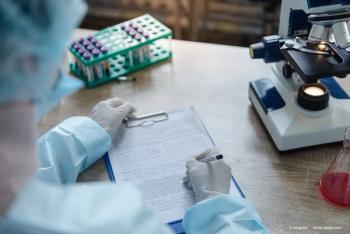
Inhibition of PlGF shows additional features compared to VEGF inhibition
Anti-vascular endothelial growth factor (VEGF) remains the gold standard therapy for diabetic retinopathy, but “when treating diabetic macular edema (DME), “about half of the patients treated with VEGF inhibitors do not respond to therapy,” said Tine Van Bergen, PhD, a scientist with ThromboGenics, Leuven, Belgium.
Anti-vascular endothelial growth factor (VEGF) remains the gold standard therapy for diabetic retinopathy, but “when treating diabetic macular edema (DME), “about half of the patients treated with VEGF inhibitors do not respond to therapy,” said Tine Van Bergen, PhD, a scientist with ThromboGenics, Leuven, Belgium.
Concerns about potential side effects can include vessel regression, fibrovascular membranes, and neurodegeneration, she noted.
The company is exploring a possible alternative to anti-VEGF therapy--placental growth factor (PlGF)-and evaluating its effect on the different hallmarks of diabetic retinopathy in experimental murine models with THR-317, a humanized antibody against PlGF. THR-317 is the only drug in development that targets solely PlGF, she noted.
PlGF is a member of the VEGF family and binds to VEGFR-1, not VEGFR-2. Clinical evidence suggests there are increased PlGF levels in vitreous and aqueous humor of diabetic retinopathy. Preclinical evidence suggests PlGF or VEGFR-1 inhibition may have a therapeutic effect.
Study details
The in vivo efficacy of THR-317 (0.77 - 5.4 µg/eye) was evaluated in diabetic streptozotocin (STZ; n = 15-30/group) and Akimba mouse models (n = 20-27/group) and in the laser-induced mouse model of choroidal neovascularization (CNV; n = 10-20/group). The steptozotocin and Akimba mouse models were chosen as they reflect the retinal changes comparable to those found in humans with diabetes.
Intravitreal administration of the anti-PlGF antibody THR-317 was compared with anti-VEGFR-2 antibody (3.1-6.2µg/eye), aflibercept (2.4 -20 µg/eye), synthetic corticosteroid triamcinolone acetonide (40 µg/eye), and a phosphate-buffered saline as negative control.
In the diabetic STZ and Akimba mouse models, repeated intravitreal administration of THR-317 reduced vascular leakage by 34 ± 14% and 22 ± 13% (p < 0.05), respectively. Administration of the anti-VEGFR-2 antibody showed similar effect--the anti-PlGF antibody improved pericyte coverage in the CNV model, but no effect was seen after anti-VEGFR-2 antibody administration, according to Dr. Van Bergen.
Results are in line with previously published studies in diabetic PlGF +/- mice, she said.
THR-317 also inhibited inflammation in 86% of the diabetic Akimba mouse models. Its ability to inhibit inflammation was “comparable” to aflibercept, she added.
Administration of THR-317 and triamcinolone similarly reduced collagen I and total collagen deposition with 40 ± 5% and 35 ± 8% (p < 0.001), respectively, while no effect was observed after the equimolar anti-VEGFR-2 (p = 0.82) or the aflibercept administration (p = 0.66), Dr. Van Bergen said.
THR-317 offers the potential for standalone treatment in DME and as a combination treatment with any anti-VEGF therapy, she noted.
“THR-317 might overcome unmet medical needs of non- or poor responders to anti-VEGF therapy,” she added.
Future plans
A phase II trial started this past January, evaluating the safety and efficacy of THR-317 for the treatment of diabetic macular edema (DME). This will be a single-masked, multicenter study to evaluate two doses of THR-317, and the company expects to have the study completed with results by the first quarter of 2018.
This study aims to evaluate the safety of THR-317 4 mg or 8 mg as the primary endpoint, and to assess efficacy in improving visual acuity and reducing central subfield thickness in subjects with center-involved DME.
Tine Van Bergen, PhD
This article was adapted from a paper presented by the ThromboGenics research team at the 2017 meeting of the Association for Research in Vision and Ophthalmology. Dr. Van Bergen is an employee of ThromboGenics NV.
Newsletter
Keep your retina practice on the forefront—subscribe for expert analysis and emerging trends in retinal disease management.










































